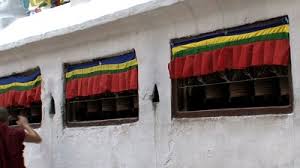Boudhanath History and Beauty
Posted by
Unknown
Wednesday, December 10, 2014 at 11:16 PM
0
comments
Labels :
120ft in diameter , There is width and 43m in height, Its simplicity of
form is its principal feature, unique among monumental stupas in the
valley in its lack of the appended five shrines of the Buddha. Some
consider it represents the Adi Buddha, the first or Primordial
Buddha,free of conceptual emanations, Only the steps built into it on
the north side, seemingly ladder that sakyamuni ascended into Tushita
heaven, breaks its uniformity.
A
thick layer of whitewash cats the dome and the form of a double lotus
depicted in saffron water colors it. This can be sponsored on various
auspicious dates, and is also done annually on Dasain Purne occurring n
the Full Moon in September by the Boudhanath Area Development Committee.
Beneath
the dome, is an added terrace with a remarkable 108 niches filled with
stone sculptured deities of the Nyingmapa School's pantheon. They
replace the usual five Buddha shrines in delining the content of the
stupa-mandala, these image were almost certainly commissioned all at
once at sakya Zangpo in the 16th century, when the present stupa was
built or there after. The
principal dawn and dusk rite of worship of the stupa in a clock wise
direction( this is known as Kora). turning the Mani wheels fixed in the
surrounding wall and reciting mantras of the deity of compassion.
The
principal dawn and dusk rite of worship of the stupa in a clock wise
direction( this is known as Kora). turning the Mani wheels fixed in the
surrounding wall and reciting mantras of the deity of compassion. This usually preceded and concluded in prayer to the three jewels and
is said to be most effective at dawn or dusk n the 10th,15th and final
day of lunar month and ups various specific auspicious festival days. It
is during these occasions the Boudhanath is said to be truly alive.
This usually preceded and concluded in prayer to the three jewels and
is said to be most effective at dawn or dusk n the 10th,15th and final
day of lunar month and ups various specific auspicious festival days. It
is during these occasions the Boudhanath is said to be truly alive.
As
in other stupa architecture, this stupa also has Varochana at the
center following by Aksobhya,Ratna Sambhava, Amitabha and Amogha Siddhi
in east, south,west and north direction respectively. Similarly, there
are one hundred and eight small niches around the stupa accomodating the
icons of Buddhas, Bodhisatavs and other female deities along with
conjoint figure in erotic poses. Likewise, at the bottom level, it is
surrounded with the praying wheels embossed with the famous mantra Om
Mani Padme Hum Fixed in more than hundred and forty inches.
Subscribe to:
Post Comments (Atom)















